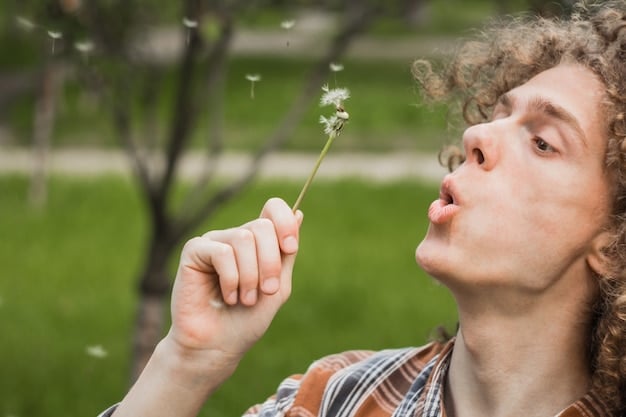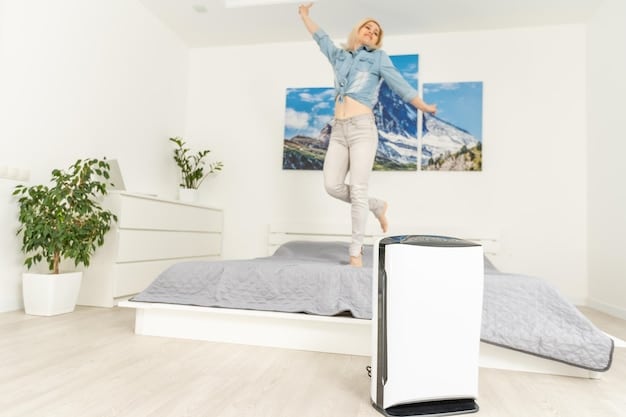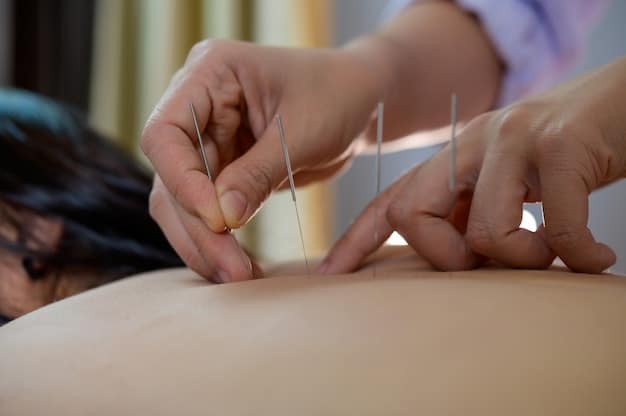Practical Solutions: Manage Spring Allergies Without Medication

Navigating spring allergies without relying on medication is achievable through a multi-faceted approach focusing on environmental control, lifestyle adjustments, and natural remedies, offering sustainable relief for those affected by seasonal pollen.
As spring unfurls its vibrant tapestry of blooms and budding trees, it also ushers in a less welcome guest for many: seasonal allergies. For those seeking respite without turning to pharmaceuticals, understanding the mechanisms behind allergic reactions and implementing proactive, natural strategies is key.
Understanding Seasonal Allergies
Seasonal allergies, often referred to as hay fever or allergic rhinitis, are an immune system overreaction to airborne particles like pollen. When these allergens are inhaled, the body perceives them as threats, triggering a cascade of responses designed to expel them, leading to symptoms such as sneezing, watery eyes, nasal congestion, and itching. This immune response involves the release of histamine and other chemicals, which cause inflammation and discomfort. While medication often targets these chemical reactions, a deeper understanding of the triggers and the body’s natural defenses can pave the way for non-pharmacological management.
The timing and intensity of allergy seasons vary significantly based on geographic location and specific pollen types. Tree pollen typically dominates early spring, followed by grass pollen in late spring and early summer, and finally weed pollen peaking in late summer and fall. Monitoring local pollen forecasts becomes a powerful tool in prevention, allowing individuals to anticipate high-pollen days and adjust their activities accordingly. This proactive stance is fundamental to an effective non-medication strategy, enabling a more informed approach to daily routines.
Common Spring Allergens
Spring’s beauty is often accompanied by a surge in specific allergens that can turn outdoor activities into a misery for sensitive individuals. Identifying the primary culprits in one’s environment is the first step toward effective avoidance.
- Tree Pollen: Early spring sees a flourish of tree pollen from oaks, elms, maples, and birches, which are significant triggers for many.
- Grass Pollen: As spring progresses into early summer, various grass species become major contributors to airborne allergens.
- Mold Spores: Thriving in damp conditions often found in melting snow or spring rains, mold spores can also be a potent allergen.
Knowing which allergens are predominant in your local area and during specific periods of spring empowers you to tailor your prevention strategies. This knowledge, coupled with an awareness of your personal triggers, forms the cornerstone of managing your symptoms effectively without relying on medications.
Environmental Control for Allergy Management
Controlling your immediate environment is perhaps one of the most effective non-medicinal strategies for managing seasonal allergies. By minimizing exposure to allergens, individuals can significantly reduce the frequency and severity of their symptoms. This approach involves proactive measures both inside and outside the home, creating sanctuaries from irritating pollen.
The goal of environmental control is to create a low-allergen zone, particularly in spaces where you spend a significant amount of time, such as your bedroom. This means not only preventing allergens from entering but also regularly removing any that might have infiltrated. Simple, consistent habits can make a dramatic difference in overall comfort and well-being during peak allergy season.
Creating an Allergen-Free Home
Transforming your home into a fortress against pollen requires diligence and strategic adjustments. These measures aim to keep outdoor allergens out and maintain indoor air quality.
- Keep Windows Closed: On high-pollen days, especially during mid-morning to early afternoon when pollen counts are highest, keep windows and doors shut to prevent allergens from drifting inside.
- Use Air Conditioning: Employ air conditioning with high-efficiency particulate air (HEPA) filters in your home and car to filter out pollen. Ensure filters are cleaned or replaced regularly.
- Regular Cleaning: Dust surfaces with a damp cloth and vacuum frequently using a vacuum cleaner equipped with a HEPA filter to capture allergens rather than redistribute them.
Beyond these foundational steps, consider removing carpets and heavy drapes, which can trap allergens, opting instead for hard flooring and washable blinds. Regularly washing bedding, especially pillowcases, in hot water can also help eliminate trapped pollen, ensuring a more restful and symptom-free night’s sleep. These practices collectively contribute to a healthier indoor environment, reducing the burden on your immune system.

Lifestyle Adjustments for Allergy Relief
Beyond controlling your indoor environment, making specific lifestyle adjustments can significantly impact your ability to manage seasonal allergies without medication. These changes involve modifying daily habits and routines to reduce exposure and fortify your body’s natural defenses. The emphasis is on proactive behavior and mindful living during allergy season.
From how you dress to when you exercise, small modifications can add up to substantial relief. Adopting these habits not only helps in symptom management but also promotes overall well-being, fostering a more resilient immune response to environmental triggers. Consistency is paramount for maximizing the benefits of these lifestyle interventions.
Daily Habits to Reduce Pollen Exposure
Integrating simple habits into your daily routine can create a protective barrier against external allergens, preventing them from entering your living spaces and impacting your health.
- Shower Before Bed: Rinse off pollen from your hair and skin before going to sleep to avoid transferring allergens to your bedding.
- Change Clothes: After spending time outdoors, change out of your clothes immediately and put them in the laundry to prevent spreading pollen indoors.
- Wear Protective Gear: When gardening or doing yard work, wear a wide-brimmed hat, sunglasses, and a mask to minimize direct exposure to pollen.
Furthermore, avoid drying laundry outdoors during high-pollen days, as pollen can easily adhere to clothes and linens. Washing pets regularly if they spend time outdoors can also help, as their fur can carry significant amounts of pollen indoors. These diligent habits, though seemingly minor, play a crucial role in reducing your overall allergen load and can make spring much more enjoyable.
Dietary Approaches and Herbal Remedies
The foods we consume and the natural compounds found in certain herbs can profoundly influence our body’s inflammatory response, offering a complementary strategy for managing seasonal allergies sans medication. A holistic approach often incorporates dietary changes aimed at reducing inflammation and bolstering immune function, alongside the thoughtful use of traditional herbal remedies.
While no single food or herb is a magic bullet, a consistent focus on an anti-inflammatory diet, rich in antioxidants and vital nutrients, can create a less reactive internal environment. Similarly, select herbs have long been recognized for their antihistamine or anti-inflammatory properties, providing a natural alternative to synthetic drugs. However, it is always wise to consult with a healthcare professional before integrating new supplements, especially if you have underlying health conditions.
Natural Anti-Inflammatories and Supplements
Embracing a diet rich in certain nutrients and considering specific supplements can aid in mitigating allergic reactions. These elements work by reducing systemic inflammation and stabilizing immune responses, providing a natural buffer against allergens.
- Omega-3 Fatty Acids: Found in fish oil, flaxseeds, and walnuts, these have potent anti-inflammatory effects that can soothe allergic responses.
- Quercetin: A flavonoid present in onions, apples, and berries, quercetin acts as a natural antihistamine, helping to stabilize mast cells that release histamine.
- Vitamin C: A powerful antioxidant, Vitamin C can reduce histamine levels and strengthen the immune system. Citrus fruits, bell peppers, and broccoli are excellent sources.
Additionally, some individuals find relief with local honey, theorizing that exposure to small amounts of local pollen build up immunity, though scientific evidence remains inconclusive. Incorporating probiotics, found in fermented foods like yogurt and kimchi, can also support gut health, which is intricately linked to overall immune function. These dietary choices, when combined with other strategies, offer a multifaceted approach to allergy management.
Nasal and Sinus Care Practices
Direct nasal and sinus care is a cornerstone of non-medicinal allergy management, offering immediate relief from congestion, irritation, and dryness. Flushing out allergens and soothing irritated nasal passages can significantly reduce symptoms and improve breathing. These practices are simple, low-cost, and can be easily integrated into a daily routine during allergy season.
The principle behind these methods is to physically remove pollen and other irritants that have settled in the nasal cavity, preventing them from triggering a full-blown allergic reaction. Regular use can also help maintain the natural moisture balance of the nasal passages, enhancing their protective barrier function.
Effective Nasal Rinses and Humidification
Various techniques can provide direct relief and cleansing for the nasal and sinus areas, addressing symptoms at their source.
- Saline Nasal Rinses: Using a neti pot or saline rinse bottle with distilled or sterile water and saline solution effectively flushes out pollen and mucus, reducing congestion and irritation.
- Nasal Sprays (Saline Only): A simple saline nasal spray can help moisturize nasal passages and clear out minor irritants throughout the day without medication.
- Humidifiers: Maintaining optimal humidity levels in your home, especially in the bedroom, can keep nasal passages moist and less prone to irritation, particularly helpful in dry climates or heated indoor environments.
Proper technique for nasal rinsing is crucial to avoid infection; always use sterile or distilled water and clean the device thoroughly after each use. These practices offer a soothing and effective way to manage nasal allergy symptoms, providing a sense of clear breathing and comfort without systemic drug exposure.
Acupuncture and Alternative Therapies
For those exploring options beyond conventional medicine, several alternative therapies, such as acupuncture, have garnered interest for their potential role in managing seasonal allergies. These approaches often focus on rebalancing the body’s energy pathways and enhancing its natural healing capabilities, aiming to reduce the intensity and frequency of allergic reactions over time.
While the scientific community continues to research the full extent of their efficacy, many individuals report significant relief from allergy symptoms through these methods. It’s important to approach alternative therapies with an open mind, considering them as complementary tools within a broader non-medicinal strategy, and to seek practitioners who are qualified and experienced.
Exploring Holistic Modalities
A variety of holistic and complementary therapies offer different avenues for addressing the underlying imbalances that might contribute to allergic responses.
- Acupuncture: This ancient Chinese practice involves inserting thin needles into specific points on the body. Proponents suggest it can modulate the immune system and reduce inflammatory responses associated with allergies.
- Biofeedback: A mind-body technique, biofeedback teaches individuals to control involuntary bodily functions, such as heart rate and muscle tension, which can indirectly help manage stress-induced allergy flare-ups.
- Chiropractic Care: Some theories suggest that spinal adjustments could improve nervous system function, potentially leading to a more balanced immune response.
These therapies are often part of a personalized treatment plan developed by alternative healthcare providers. They do not typically offer instant relief but work to strengthen the body’s resilience over time. When considering these options, it’s advisable to discuss them with your primary healthcare provider to ensure they align with your overall health strategy and to rule out any contraindications. The integration of such holistic practices can offer a broader spectrum of relief, empowering individuals to take an active role in their health management.

The Power of Prevention and Preparedness
Ultimately, the most effective non-medicinal strategy for managing seasonal allergies is centered on prevention and preparedness. Anticipating the arrival of pollen season, understanding your personal triggers, and having a comprehensive plan in place allows you to minimize exposure and mitigate symptoms before they become severe. This proactive mindset transforms the challenging spring season into a more manageable experience.
Being prepared means not just reacting to symptoms but actively working to avoid them. It involves a combination of consistent daily habits, environmental adjustments, and a nuanced understanding of local pollen patterns. This foresight not only reduces immediate discomfort but also contributes to long-term well-being, fostering a greater sense of control over your health.
Developing a Personalized Allergy Action Plan
Creating a specific plan tailored to your needs is crucial for navigating allergy season without medication. This involves monitoring, adapting, and consistently applying protective measures.
- Monitor Pollen Forecasts: Regularly check local pollen counts and weather reports, adjusting outdoor activities accordingly, especially on high-pollen days.
- Plan Outdoor Activities: Schedule outdoor excursions for times when pollen counts are typically lower, such as early morning or late evening, or immediately after a rain shower.
- Maintain Consistency: Adhere diligently to environmental controls, dietary adjustments, and personal hygiene routines to keep allergen levels consistently low.
Furthermore, keeping a symptom diary can help you identify specific triggers and evaluate the effectiveness of different non-medicinal strategies. This personalized data can be invaluable in refining your approach each season, leading to more targeted and effective management. By combining awareness with consistent action, individuals can significantly reduce the impact of seasonal allergies on their lives, enjoying spring more fully without the need for medication.
| Key Strategy | Brief Description |
|---|---|
| 🏠 Environmental Control | Minimize indoor allergens by keeping windows closed, using HEPA filters, and regular cleaning. |
| 🏃♀️ Lifestyle Adjustments | Shower before bed, change clothes, and wear protective gear outdoors to reduce pollen exposure. |
| 🍎 Dietary & Herbal Aids | Incorporate anti-inflammatory foods, Omega-3s, Quercetin, and Vitamin C to support immune health. |
| 👃 Nasal & Sinus Care | Utilize saline rinses and maintain home humidity to clear and soothe nasal passages. |
Frequently Asked Questions About Allergy Management
While diet alone may not eliminate allergy symptoms, incorporating anti-inflammatory foods rich in omega-3s, quercetin, and vitamin C can support your immune system and potentially reduce the severity of allergic reactions. These nutrients help to stabilize mast cells and manage histamine release, contributing to a less reactive internal environment during allergy season.
During peak allergy season, it is recommended to clean your home frequently, ideally dusting with a damp cloth and vacuuming with a HEPA-filtered vacuum at least once or twice a week. Washing bedding in hot water weekly also significantly helps remove trapped pollen and dust mites, creating a cleaner and more comfortable living space.
Humidifiers can be helpful for allergy relief by keeping nasal passages moist, which can prevent dryness and irritation. However, it’s crucial to clean them regularly to prevent mold growth, which can exacerbate allergy symptoms. Maintaining indoor humidity levels between 30-50% is generally recommended for optimal comfort and allergen control.
Pollen counts are typically highest during the mid-morning to early afternoon hours. Therefore, the best times to schedule outdoor activities, if unavoidable, are usually early morning or late evening. Pollen counts often decrease after a good rain shower as the rain washes pollen out of the air, offering another opportune window for outdoor activities.
Some essential oils, such as lavender, peppermint, and eucalyptus, are often explored for their potential to alleviate allergy symptoms through aromatherapy or topical application. While they might provide symptomatic relief, especially for congestion, they should be used with caution and diluted properly. Always consult with a healthcare professional before incorporating them into your allergy management plan.
Conclusion
Navigating the beauty of spring without the burden of seasonal allergy medication is not only possible but increasingly achievable through a multifaceted and personalized approach. By systematically implementing environmental controls, adopting mindful lifestyle adjustments, exploring dietary enhancements, and incorporating direct nasal care, individuals can significantly mitigate their symptoms. The integration of complementary therapies like acupuncture and a strong emphasis on consistent prevention further empower those seeking natural relief. Embracing these practical solutions fosters a greater sense of control over one’s health, allowing for a more enjoyable and symptom-free transition through the vibrant spring months. This holistic strategy underscores the body’s inherent capacity for resilience when supported by informed choices and consistent care.





